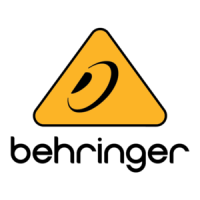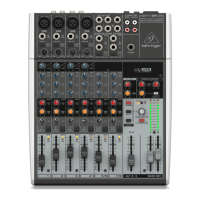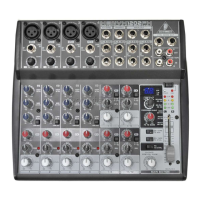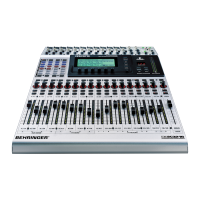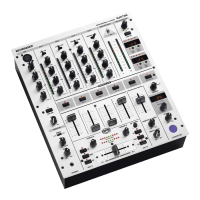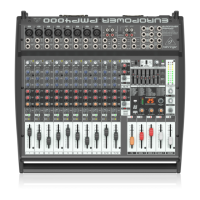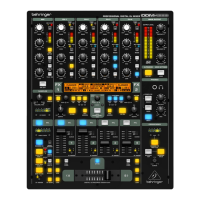15
B-CONTROL
DEEJAY
BCD3000
6.3 Receiving MIDI commands
The reception of MIDI data also allows for transmitting commands
from third-party DJ software to your BCD3000. Although this
function is not necessary to control the device from the software,
you can still display the switching status of button LEDs, which
enables you to work more intuitively.
All button LEDs receive MIDI control change data (on/off). If the
controller value transmitted is between 0 and 63, this value
corresponds to the switched-off status (LED off). If the value is
64 or higher (max. 127), the LED illuminates.
Group Name
MIDI CC no.
LOW KILL 24
MID KILL 23
HIGH KILL 22
RELOOP
21
SYNC
20
SCRATCH
19
PLAY
18
CUE
17
LOW KILL 16
MID KILL 15
HIGH KILL 14
RELOOP
13
SYNC
12
SCRATCH
11
PLAY
10
CUE
9
EXT IN A
8
EXT IN B
7
ON (FX unit active)
6
FX
(preset down)
5
FX
(preset up)
4
ACTION (or TAP)
3
CUE A
2
CUE B
1
KEY DECK
A+B
KEY DECK A+B 25
CUE SELECT
DECK B
INPUT
SELECT
FX CONTROL
DECK A
Table 6.5: MIDI commands for receiving button LED statuses
Data request for all moving elements:
If the “Data Request” command (demand for data) is sent from a
suitable software application to the BCD3000 as “Control Change”
command (100) on MIDI channel 1, the B-CONTROL transmits its
current controls settings to the MIDI or DJ software application.
This affects all knobs and faders apart from both wheels and
buttons.
MIDI channel MIDI CC no.
CH.1
100
Table 6.6: Controller for data request
Selecting the input channel:
You can select the analog input A (see chapter 2.3) via MIDI. To
do this, a program change command must be sent to the
BCD3000.
ANALOG INPUT A
selection
MIDI channel MIDI message
CH. 1
IN
CH. 1
Program Change
Table 6.7: Switching the analog input using program change
commands
Acceleration behavior of the Wheels:
Both wheels are automatically selected when the acceleration
option is switched on. The quicker you turn one of the wheels,
the stronger the value changes. In TRAKTOR 3 LE, this means
the following:
V In PLAY mode, you can speed up or slow down the track
quicker.
V In PAUSE mode, you can move quicker through the track.
The value change relates directly to the wheel’s speed when
scrolled manually. When the SCRATCH button is activated, the
acceleration is temporarily turned off in order to ensure an optimum
scratch behavior.
In case you want to deactivate the acceleration when using
other MIDI software applications, apply a MIDI command that is
transmitted from the MIDI application to the BCD3000. After doing
so, the value changes will be constant when scrolling the wheel
(left turn: 63, right turn: 65), regardless how quick.
MIDI Channel
MIDI CC no.
Value Behavior
0-63
Wheels Acceleration =
off
64-127
Wheels Acceleration =
on (default)
CH.1
99
Table 6.8: Switching between wheels’ accelerations
6. MIDI CONTROL
